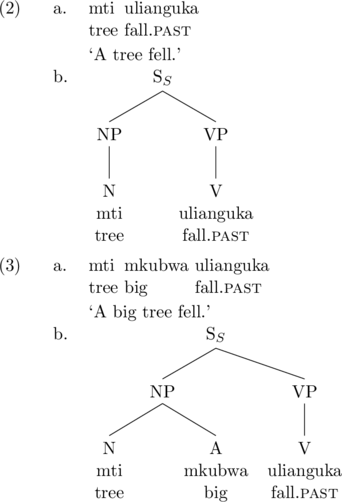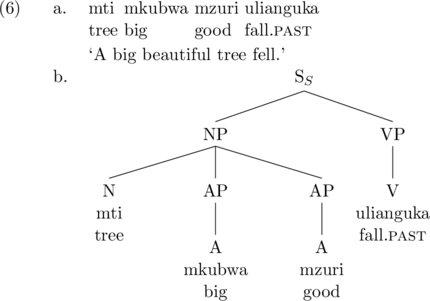4
Learning Objectives
By the end of this chapter you should,
- be able to build a phrase structure grammar by looking at data,
- recognize and interpret constituency tests in another language,
- use a phrase structure grammar to build trees,
- have a basic grasp of Swahili syntax, and
- understand the principles behind a data-driven approach to syntactic theory
Building a Grammar
We now to turn to the question of building an accurate phrase structure grammar. We want our phrase structure rules to be empirically correct, and so they need to correctly describe all and only the phrases that exist in a language. To emphasize a central point of the last chapter, we want our phrase structure grammar for language X to precisely reflect how language X organizes its information. In this chapter, we’ll work through how we might accomplish this with Swahili.
Swahili (or Kiswahili as it is pronounced in Swahili) is a Bantu language spoken throughout East Africa by upwards of 100 million people. It is a national language of Kenya, Tanzania, and Uganda, and the Democratic Republic of Congo, and it is also spoken in Rwanda, Burundi, Malawi, Somalia, Zambia, and Mozambique.

You can learn to speak Swahili here at KU! Courses are offered every semester and over the summer through the African and African American Studies Department.
Building a Noun phrase rule
Let’s try to figure out the phrase structure rules for Swahili nouns. To do this we simply look at (a lot of) data, applying constituency tests. We start small, and then build up. For the sake of simplicity, we will not take the time to confirm all the constituency tests for each phrase that we build. But if we were being diligent, then we would do exactly that.
The following is our first set of data.[1]
![Rendered by QuickLaTeX.com \ex. \ag. mti ulianguka\\ tree fall.\textsc{past}\\ \trans `A tree fell.' \bg. mti mkubwa ulianguka\\ tree big fall.\textsc{past}\\ \trans `A big tree fell.' \cg. Ndio, huu ulianguka\\ Yes, \textsc{dem} fall.\textsc{past}\\ \trans `Yes, that fell.' \hfill [that=A big tree] \dg. mti mkubwa na mti mdogo ilianguka\\ tree big and tree small fall.\textsc{past}\\ \trans `A big tree and a small tree fell.'](https://pressbooks.pub/app/uploads/quicklatex/quicklatex.com-1819f0af6735343696fd96a6a56c5a43_l3.png)
These sentences provide a wealth of information. First, it looks like in Swahili (just like in English) subjects come before the verb. But based on (1a) and (1d), it looks like adjectives go after nouns in Swahili. The third and fourth sentences are constituency tests (substitution and coordination), showing that the sequence noun-adjective is a constituent in Swahili. With the information from (1), we can write some rules. Let’s assume that the category of the noun-adjective sequence is a Noun Phrase (NP). We’ll revisit that question in the next chapter.
Swahili grammar fragment (in progress)
- SS → NP V
- NP → N
- NP → N A
Now our grammar fragment for Swahili allows us to draw the following trees—that is, it represents Swahili’s structure in the following ways.

- XP → XP conj XP
Here, “XP” means any phrase—“X” is a variable over categories. The important things to note about this rule is that it only allows coordination of the same category. That is, XP doesn’t consist of XP conj YP. Practically, this means that a Noun Phrase can only be coordinated with another Noun Phrase. A Verb Phrase can only be coordinated with another Verb Phrase, etc.
The category “conj” is short for conjunction; there are many different conjunctions: and, but, nor, yet, …
Coordination (length: 1m 22s)
We have two rules for NP. There is a convention for collapsing this into one rule, which is to use parentheses. So the two NP rules above can be re-written as the single rule below.
Swahili grammar fragment (in progress)
- SS → NP V
- NP → N (A)
The second rule can be read, “A Noun Phrase consists of a noun, which is optionally followed by an adjective.” To be clear, the second rule contains the information of both NP rules from our first grammar fragment, it’s just a conventionalized representation.
Let’s look at more sentences.

We learn here that, in fact, nouns in Swahili can be followed two or three adjectives. Indeed, we could keep going! Noun Phrases in Swahili can involve an infinitive number of adjectives (up to cognitive limitations).[2] Again, we have a convention to express this in a single rule.
Swahili grammar fragment (in progress)
- SS → NP V
- NP → N (A)+
The second rule can be read, “A Noun Phrase consists of a noun which is optionally followed by any number of adjectives.” Note that we are working under the assumption that “fewer rules is better.” That is, eventually, we want the phrase structure grammar that is the simplest, where “simplest” here means “uses the fewest amount of rules.”

There’s a more important message that our NP rule illustrates. Notice that whenever we put two things together—whether we’re making a compound or making a phrase—the result always has the category of one of the pieces we’ve put together. When we put together an adjective and a noun, we name the resulting constituent a Noun Phrase—not a Verb Phrase, not a Prepositional Phrase, etc. This is because the resulting constituent is still “noun-y,” not “verb-y” or “preposition-y.” As a rule, a phrase will always be named after one of the heads that it contains. Thus, every phrase, by definition has a head. That is to say, a Noun Phrase contains a noun, a Verb Phrase contains a verb, an Adjective Phrase contains an adjective, etc.
And vice versa! We will assume that the opposite is true as well. Every noun is in a Noun Phrase, every verb is in a Verb Phrase, and every adjective is in an Adjective Phrase.
We will refer to these two properties of heads as the Headedness Principle.
Every phrase has exactly one head and every head is in its phrase.
Though we will see more motivation for this later, for now it suffices to recognize that adopting the Headedness Principle greatly reduces the number of rules we need. If we simply assume that all nouns, verbs, adjectives are in phrases, then we don’t need to list two rules for each category.
However, once we adopt the Headedness Principle, then we have to adjust our rules. It is no longer possible to have a rule like NP → N (A)+ because there is a head, A, that is not in its phrase. Same for V inside SS. To fix this issue, we need a few more rules, specifically, we need at least one rule for every head.
Swahili grammar fragment (in progress)
- SS → NP VP
- VP → V
- NP → N (AP)+
- AP → A
With the Headedness Principle and these new rules, we can re-draw the tree from (5) as in (6).

One immediate benefit of adding in these extra layers is that now we have a place to put adverbs—which also need to be in a phrase! The example in (7a) demonstrates where adverbs go with respect to adjectives, and the example in (7b) demonstrates through coordination that adjectives and adverbs form a constituent

Swahili grammar fragment (in progress)
- SS → NP VP
- VP → V
- NP → N (AP)+
- AP → A (AdvP)
- AdvP → Adv


From these sentences we learn something about adpositional phrases. Swahili appears to have the category preposition; the adposition comes before the noun. (It is a preposition as opposed to a postposition; postpositions come after nouns.) We should add a rule like PP → P NP, but where do we put it? Notice that we have more than one thing that can come after the noun, a prepositional phrase and an adjectival phrase. Which order should they go in?
In order to answer this question, we need to look at examples that includes both an adjective and a prepositional phrase. (This is the first case in which we’re actually using data to clarify our model. Previously, we had just been taking data and modeling. But now we’re specifically seeking our particular data to determine what our model should look like.)

From this example, we conclude that adjectives precede prepositional phrases.
Swahili grammar fragment (in progress)
- SS → NP VP
- VP → V
- NP → N (AP)+ (PP)
- AP → A (AdvP)
- AdvP → Adv
- PP → P NP
So now we can draw the following tree using our phrase structure grammar for Swahili.

Building a Verb phrase rule

Again, these two sentences provide an enormous amount of information. We’ll concentrate on two things. First, just like in English, the object of the verb comes after the verb. (Such languages are called verb-medial languages; we’ll return to cross-linguistic variation in chapter 6.) The second point is that the verb and object form a constituent to the exclusion of the subject. This fact is demonstrated through the coordination test in (12b). We can describe both of these properties by making the minimal adjustment to our VP rule: we add in an optional NP!
Swahili grammar fragment (in progress)
- SS → NP VP
- VP → V (NP)
- NP → N (AP)+ (PP)
- AP → A (AdvP)
- AdvP → Adv
- PP → P NP

Our grammar fragment can continue indefinitely until we have developed a full descriptive grammar of Swahili. For instance, we can develop rules for adverbs in VP (15a), for double-object constructions (15b) (see chapter 10) and for questions (15c).

We won’t bother going too in-depth in this endeavor, because in the next chapter we’ll refine our theory slightly. But it is important at this point to re-emphasize what exactly we’re trying to do when we build a phrase structure grammar. We’re attempting to build an accurate description of a language. The way that we’re doing this is by applying constituency tests. Note that we’re also (implicitly) applying tests to determine category as well. I stipulated above that words like ulianguka and alicheka were verbs. This is not because when I translate them in English, the English word is a verb. It is because, in Swahili, the words have properties of being verbs. In particular, they inflect for person and number marking in their prefixes (in the examples above, the first vowel of the verb is always the subject agreement), and they also inflect for tense marking. (Past tense in Swahili is expressed by the prefix li-.) The words are also distributionally verbs: they occur in between subjects and objects.
This basic approach, using constituency tests and identifying categories will not change as we move forward, even as we update our theoretical model. Indeed, these two things are the very heart of all syntactic research. We use empirical evidence to motivate a theoretical model. Our model will eventually be more sophisticated, but only as a response to the data that we look at.
Tree drawing with phrase structure grammars (length: 1m 41s)
Where we’re going
On the approach taken in this chapter, we assume that all languages have a distinct phrase structure grammar. That is, for any one language, the rules are idiosyncratic to that language. We just look at the data and determine what those rules are. And if language X and language Y in fact share the exact same rules, then they’re the same language! (Like if x=2 and y=2 then x=y.)
As we’ll point out in the next chapter, though, the idea that every language is different is actually somewhat misleading. Languages turn out to be much more similar than they are different. For instance, it is robustly attested across languages that the object and verb form a constituent to the exclusion of the subject. It is also robustly attested across languages that if adjectives go after nouns in language X, then the object goes after the verb in language X as well.
On the approach developed in this chapter, these similarities and patterns go unexplained. That is, given our current model, it is essentially entirely arbitrary how a language can put its pieces together, or better, how a language organizes its information. But when we truly look at a lot of cross-linguistic data, we find that this doesn’t seem right. Ideally, our theoretical model isn’t just adequate for, e.g., Swahili, but for all languages. This is what we’re going to work towards in the next chapter. We’ll look at more data, and attempt to build a theory of syntax that applies to any human language.
Things to remember
- the Headedness Principle
- the coordination rule
- how to use constituency tests to infer structure
- how to draw trees using phrase structure grammars
Advanced
Complexity in Phrase Structure Grammars
How complex can a phrase-structure grammar get? The answer is: very. Consider the following rules, taken from one of the standard syntax textbooks.[3]
- CP → (C) TP
- TP → {NP/CP} (T) VP
- VP → (AdvP+) V (NP) ({NP/CP}) (AdvP+) (PP+) (AdvP+)
- NP → (D) (AdjP+) N (PP+) (CP)
- PP → P (NP)
- AdjP → (AdvP) Adj
- XP → XP conj XP
- X → X conj X
One notational addition in these rules are the braces: “{…/…}”. These are used to mean “either/or (but not both at once).” So the rule for TP, either an NP (what we have called DP in this textbook) or a CP can preceded T, i.e., be a subject. This accounts for sentences like The noise surprised Malika and That Jessie came home late surprised Malika. The latter sentence has a CP subject: that Jessie came home late is the subject of surprised.
Notational differences aside, it is important to note in these rules that basically anything goes—as long as there is empirical motivation. So the reason that the VP is so long is because VP can have a lot of stuff in them. This is empirically necessary. But note that there really is not upper limit how how complex a rule can be. This is not a good outcome. Because it predicts that Human Languages can be random. That is, it reduces every Human Language to an unpredictable system of rules describing each phrase. This turns out to be incorrect. As we’ll discuss in the next chapter, Human Languages are actually extremely systematic, meaning that, all things considered, the rules that describe a language tend to look very similar to each other. There is very little “randomness” in any given language.
But the complex Phrase Structure Grammars serve a purpose. First, empirically, they show that phrases are complex creatures, often consisting of multiple distinct pieces. The Phrase Structure Grammars are complex because Human Language is complex (which is different from saying that Human Language is random/unpredictable). Second, the rules above serve a theoretical purpose.
Rule or transformation?
Sometimes, it’s not clear when looking at data whether we should treat the given phrase as the result of a Phrase Structure Rule, or the result of a transformation. The term “transformation” is used to describe any changes that apply to a sentence. For instance, we typically describe topicalization as being derived via transformation. Recall that with topicalization, some constituent is moved to the beginning of the sentence.
![]()
Should we make a Phrase Structure Rule to describe (16b)? The answer is usually taken to be “no.” Why not? Because we can describe this kind of a sentence via a “rule of transformation,” that is, a rule that describes a generalized process for turning one kind of sentence into another kind of sentence. In the case of topicalization, the rule is simple: place whatever you want to topicalize at the beginning of the sentence.
Rules of transformation serve a dual purpose. On the one hand, they underscore the overall goal of reducing Human Language to a set of abstract rules that can apply to an infinite number of sentences. With a rule that describes topicalization, I can topicalize anything I want.
On the other hand, rules of transformation associate particular word orders with particular meanings. This is crucial. The order of DP DP V in English is uniquely associated with the meaning of topicalization. This differentiates it then from the more basic word orders that our Phrase Structure Rules generally describe. For instance, the order V DP (a basic rule for VPs in English) doesn’t “mean” a particular thing; this rule applies generally to all transitive constructions: build the house; hold a meeting; sing a tune; drop a single; … . This is the “basic” order, and it doesn’t have an inherent “meaning” associated with that order. Topicalization is different, though, because there is a meaning associated with that order. So we want a rule that applies just in that case.
It is sometimes hard to know for any given word order whether it should be derived by a transformation, or whether it should be part of the basic word orderof the language. For instance, consider adjective orders in English. While adjectives are always allowed in front of a noun, sometimes adjectives can appear after a noun.[4]
![]()
Should our DP rule include both orders of N and AP? This idea is debated, but one hint that maybe a rule of transformation can derive one of the order comes from meaning. Remember that if a particular order of words is associated with a particular meaning, then it might be better to try to derive that order via a rule of transformation. In (17), the two orders actually do have distinct meanings: the visible stars means something slightly different than the stars visible. To use the latter order (the stars visible), you have to talking about about stars that you can see right now. For instance, on cloudy night, when no one can see any stars, you can still talk about which stars are generally visible with (17a). This doesn’t quite work for (17b). If no stars are visible, it sounds funny to talk about the stars visible.
This difference in meaning suggests that more than a mere change in word order is going on. Rather, it suggests that there is a rule that transforms the order from AP N to N AP to map to a particular meaning.
The broader takeaway is the following: As we continue moving forward in describing language, we should be paying attention to not only the patterns of word order (and category and constituency), but also whether there are patterns that associate particular words orders with particular meanings. If we find such patterns, then we can create abstractions over those patters: rules! Ultimately, we won’t adopt any rules of transformation—but we will have movement, which accomplished the same thing.
- The verb changes from ulianguka to ilianguka in the last sentence because there is a plural subject. ↵
- In fact, there actually aren't very many words whose category is adjective in Swahili (as compared to, e.g., English). Moreover, using more than one in a sentence is fairly degraded. We're putting aside some issues here for the sake of exposition. ↵
- Carnie, Andrew. 2006. Syntax: A Generative Introduction, Second edition. Malden, MA: Blackwell. ↵
- Cinque, Guglielmo. 2010. The Syntax of Adjectives: A Comparative Study. Cambridge, MA: MIT Press. ↵
A family of constituency tests that tests constituency by replacing a string of words with another form, typically a pro-form.
The coordination constituency test uses conjunctions (and, but, not,...) to test for constituency.
See coordination.
An "adposition" is a functional particle or word that determines something about a following noun. Often, adpositions give information about location: on, over, under, in. English only has prepositions, because the adposition comes in front ("pre-") of the noun Many languages have "postpositions", where the adposition comes after the noun ("post-").
A grammatical role. Objects are typically complements to V.
A transitive verb has two arguments, a subject and an object.
Intransitive verbs only every appear with a subject, and never appear with an object. In theoretical terms, an intransitive verb is a verb that c-selects for only one argument.
The double-object construction is phrase that has two "objects," like John gave Mary a book.
